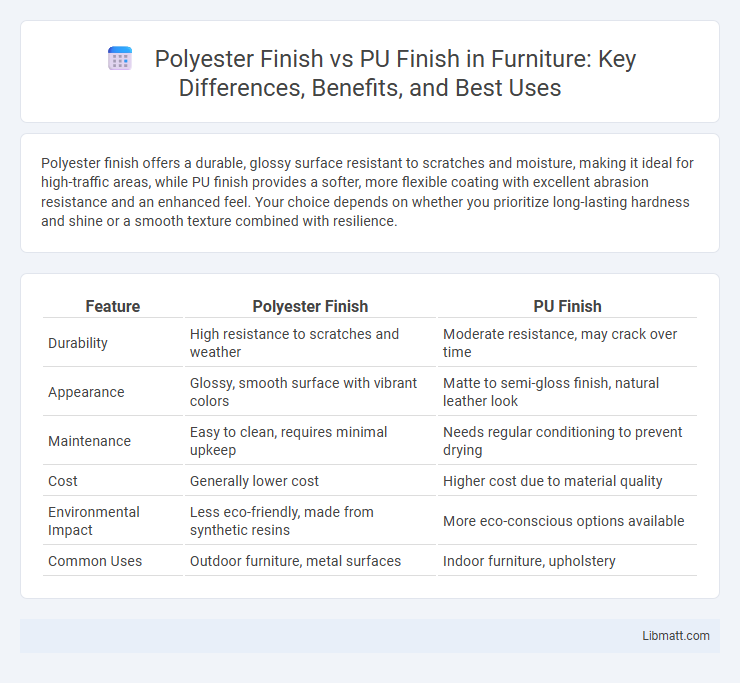Polyester finish offers a durable, glossy surface resistant to scratches and moisture, making it ideal for high-traffic areas, while PU finish provides a softer, more flexible coating with excellent abrasion resistance and an enhanced feel. Your choice depends on whether you prioritize long-lasting hardness and shine or a smooth texture combined with resilience.
Table of Comparison
| Feature | Polyester Finish | PU Finish |
|---|---|---|
| Durability | High resistance to scratches and weather | Moderate resistance, may crack over time |
| Appearance | Glossy, smooth surface with vibrant colors | Matte to semi-gloss finish, natural leather look |
| Maintenance | Easy to clean, requires minimal upkeep | Needs regular conditioning to prevent drying |
| Cost | Generally lower cost | Higher cost due to material quality |
| Environmental Impact | Less eco-friendly, made from synthetic resins | More eco-conscious options available |
| Common Uses | Outdoor furniture, metal surfaces | Indoor furniture, upholstery |
Introduction to Polyester and PU Finishes
Polyester finish offers a durable, chemical-resistant surface commonly applied to textiles and automotive parts, enhancing longevity and color retention. PU finish, or polyurethane finish, provides a flexible, waterproof coating widely used in fashion and upholstery for its softness and abrasion resistance. Both finishes improve material performance but differ in texture, flexibility, and application suitability.
What is Polyester Finish?
Polyester finish is a durable coating made from synthetic polymer resins that enhances the surface protection of various materials, including textiles, furniture, and automotive parts. It provides excellent resistance to abrasion, moisture, and UV rays, making it ideal for outdoor and high-use applications. Your choice of polyester finish ensures extended longevity and a glossy or matte look depending on the formulation.
What is PU (Polyurethane) Finish?
PU (Polyurethane) finish is a versatile synthetic coating known for its durability, flexibility, and resistance to abrasion and chemicals. Commonly used in textiles and furniture, PU finish creates a smooth, protective layer that enhances material longevity and water resistance. Its elasticity and strong adhesive properties make it ideal for applications requiring both aesthetic appeal and functional performance.
Key Differences Between Polyester and PU Finishes
Polyester finishes offer excellent durability, chemical resistance, and a glossy appearance, making them ideal for high-wear surfaces and outdoor applications. PU (polyurethane) finishes provide superior flexibility, abrasion resistance, and a softer feel, commonly used in upholstery and automotive interiors. The primary difference lies in polyester's rigidity and chemical resilience versus PU's elasticity and comfort.
Durability Comparison: Polyester vs PU Finish
Polyester finishes exhibit superior durability due to their high resistance to abrasion, UV rays, and chemicals, making them ideal for long-lasting applications in harsh environments. PU (Polyurethane) finishes offer excellent flexibility and impact resistance but tend to degrade faster under prolonged exposure to sunlight and harsh chemicals. For applications requiring extended wear and environmental resilience, polyester finishes provide more reliable and enduring performance compared to PU finishes.
Appearance and Aesthetics
Polyester finish offers a smooth, glossy surface with vibrant color retention, making it ideal for achieving a sleek and polished look. PU finish provides a more flexible, matte, or semi-gloss appearance that enhances texture and depth, lending a sophisticated and natural feel to surfaces. Your choice between these finishes will depend on whether you prefer a high-shine, durable coat or a softer, more tactile aesthetic.
Application and Usability
Polyester finish offers a durable, water-resistant surface ideal for outdoor furniture and automotive upholstery, providing long-lasting protection against UV rays and abrasion. PU finish delivers a softer, more flexible feel, making it suitable for fashion accessories and interior furnishings that require enhanced comfort and aesthetic appeal. Your choice depends on whether durability or comfort is the priority in your specific application.
Maintenance and Care Requirements
Polyester finishes offer excellent resistance to stains and moisture, requiring minimal maintenance such as regular wiping with a damp cloth to keep surfaces clean. PU (polyurethane) finishes provide a tougher protective layer that resists scratches and chemical damage, but they may need periodic polishing or specialized cleaners to maintain their glossy appearance. Both finishes benefit from avoiding abrasive materials and prolonged exposure to direct sunlight to prolong durability and aesthetic appeal.
Cost Implications
Polyester finishes generally offer a lower cost solution compared to PU finishes, making them ideal for budget-conscious projects. PU finishes, though more expensive, provide superior durability and a higher-quality surface that justifies the additional investment in applications demanding longevity and aesthetic appeal. The cost differential often aligns with the intended use, where PU's enhanced resistance to wear and chemicals offsets the initial expense over time.
Choosing the Right Finish: Polyester or PU?
Choosing the right finish between polyester and PU depends on your specific needs for durability, appearance, and maintenance. Polyester finish offers excellent resistance to scratches, UV rays, and impacts, making it ideal for outdoor or high-traffic applications, while PU finish provides a smoother, glossier look with better elasticity and touch, suited for indoor furniture or items requiring a softer feel. Your decision should consider the environment and usage to ensure the finish maintains its quality and appearance over time.
Polyester Finish vs PU Finish Infographic

 libmatt.com
libmatt.com